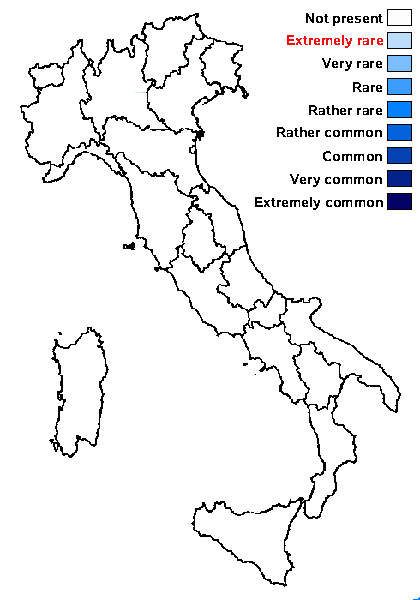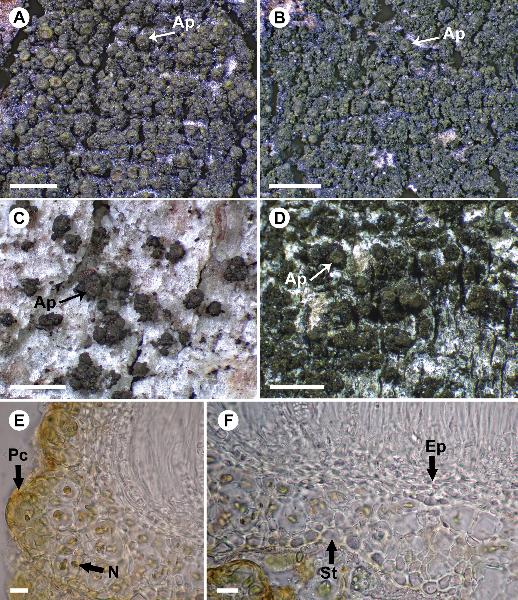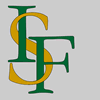Rostania effusa A. Košuth., M. Westb. & Wedin
Lichenologist, 54: 15, 2022
Synonyms:
Distribution:
Description: Thallus crustose, homoiomerous, gelatinous when wet, ecorticate, forming a thin, effuse crust of scattered to contiguous, 30-75(-100) μm wide granules resembling blastidia or goniocysts. Upper surface dark green to dark brown, dull, epruinose, semi-translucent when wet. Apothecia lecanorine, often scarce or absent, sessile, up to 0.3 mm across, globose and perithecioid when young, with an initially punctiform, later flat, red-brown disc, and a thin, persistent thalline margin. Thalline exciple up to 75 µm wide, with a simple pseudocortex; proper exciple euthyplectenchymatous, with small-ellipsoid to rectangular cells, c. 10 µm wide; epithecium brown; hymenium colourless, 85-125 µm high, K/I+ blue; paraphyses c. 1.5 µm thick at mid-level, the apical cells up to 3(-5) µm wide; hypothecium colourless, up to 20 µm high. Asci 8-spored, cylindrical-clavate, the apex strongly thickened, the apical dome K/I+ pale blue, with a downwardly projecting K/I+ deep blue tubular structure. Ascospores subglobose when young, then more or less cuboid with rounded angles and truncate ends, muriform with up to 12 cells in optical view, (8.7-)10-15(-16.3) x (8-)10-12.5(-14.5) µm. Pycnidia unknown. Photobiont cyanobacterial (Nostoc, the cells single or in clusters of 2-4). Spot tests: all negative. Chemistry: without lichen substances.Note: a recently-described species of nutrient-rich or -enriched bark, widespread in Scandinavia and also known from Slovenia; to be looked for in Italy.
Growth form: Crustose
Substrata: bark
Photobiont: cyanobacteria, filamentous (e.g. Nostoc, Scytonema)
Reproductive strategy: mainly asexual, by isidia, or isidia-like structures (e.g. schizidia)

Predictive model

Source: Košuthová A, Westberg M, Wedin M. A revision of the Rostania occultata (Collemataceae) complex in Fennoscandia. The Lichenologist. 2022;54(1):13-24. doi:10.1017/S0024282921000487 - CC BY 4.0
Rostania effusa (A, UPS L-611182; B, UPS L-088894; C, UPS L-656297; D, UPS L-929096—holotype; E & F, S F388734). A, habitus – granular thallus with an unusually large number of apothecia (Ap); note the small globose thallus granules. B, habitus – granular thallus dominated by small blastidia-like granules with apothecia (Ap). C, habitus – granular thallus forming small, scattered patches with apothecia (Ap). D, habitus – granular thallus forming scattered patches with apothecia (Ap). E, section of apothecium; note the excipulum thallinum with a simple pseudocortex (Pc) and Nostoc as single cells or 2–4 cells in clusters (N). F, section of apothecium; note the supporting tissue (St) formed by a single layer of rounded to ellipsoid cells and the euthyplechtenchymatous excipulum proprium (Ep). Scales: A–D = 1 mm; E & F = 10 μm.
Growth form: Crustose
Substrata: bark
Photobiont: cyanobacteria, filamentous (e.g. Nostoc, Scytonema)
Reproductive strategy: mainly asexual, by isidia, or isidia-like structures (e.g. schizidia)

Predictive model

 INDEX FUNGORUM
INDEX FUNGORUM
 GBIF
GBIF

